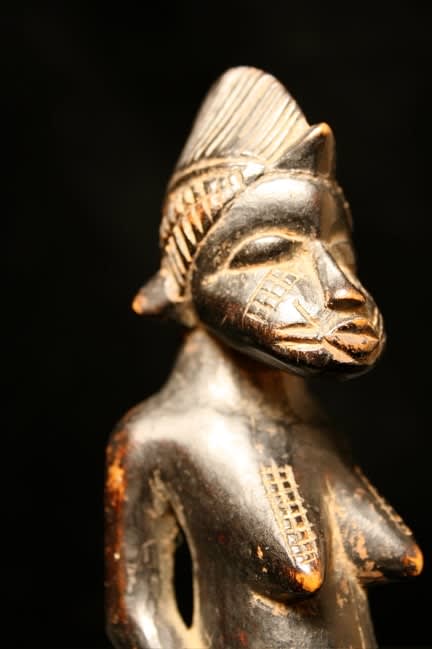Senufo Figure of a Standing Woman, 1850 CE - 1910 CE
wood
7.25
DA.408 (LSO)
This curvaceous and attractive rendering of a standing woman was carved by the Senufo group of the Ivory Coast, Burkina Faso and Mali. It is a classical representation, with slightly...
This curvaceous and attractive rendering of a standing woman was carved by the Senufo group of the Ivory Coast, Burkina Faso and Mali. It is a classical representation, with slightly bent legs (on a pedestal base), a protuberant stomach, pointed breasts, hands resting on the navel, extensive oblong keloid scarifications on face and body, a crested coiffure and a sharply-rendered face. The patina is good, and sets off the dynamic inter-relationships of curves and straights which make this such a dynamic and impressive piece, despite its relatively small size.
Pieces such as this are not as well known as the standard Senufo icon – pombilele, or rhythm pounders – although in representing half of an ancestor couple the intellectual intention is much alike. At the heart of Senufo society is a patriarchal group of elders known as the Poro, which is responsible for many religious and secular functions to do with the running of the tribal group. Smaller-scale magical issues, however, are usually dealt with by diviners or soothsayers (sandoo). Figures representing ancestors and spirits are used both centrally and in individual homes.
The Senufo group, based in the Ivory Coast and Mali area, migrated to their current location from the north during the 15th and 16th centuries AD. Their economy is primarily agricultural and settled. As a result specialist trades have become established, primary among which is the expert carver. These are typically important people, as the Senufo have a long history of using highly decorated ritual and secular objects in many aspects of everyday life. Their extremely high level of skill in woodcarving is nowhere better seen than in the realm of their magical-religious art.
This is a striking example of Senufo sculptural abilities.
Pieces such as this are not as well known as the standard Senufo icon – pombilele, or rhythm pounders – although in representing half of an ancestor couple the intellectual intention is much alike. At the heart of Senufo society is a patriarchal group of elders known as the Poro, which is responsible for many religious and secular functions to do with the running of the tribal group. Smaller-scale magical issues, however, are usually dealt with by diviners or soothsayers (sandoo). Figures representing ancestors and spirits are used both centrally and in individual homes.
The Senufo group, based in the Ivory Coast and Mali area, migrated to their current location from the north during the 15th and 16th centuries AD. Their economy is primarily agricultural and settled. As a result specialist trades have become established, primary among which is the expert carver. These are typically important people, as the Senufo have a long history of using highly decorated ritual and secular objects in many aspects of everyday life. Their extremely high level of skill in woodcarving is nowhere better seen than in the realm of their magical-religious art.
This is a striking example of Senufo sculptural abilities.
